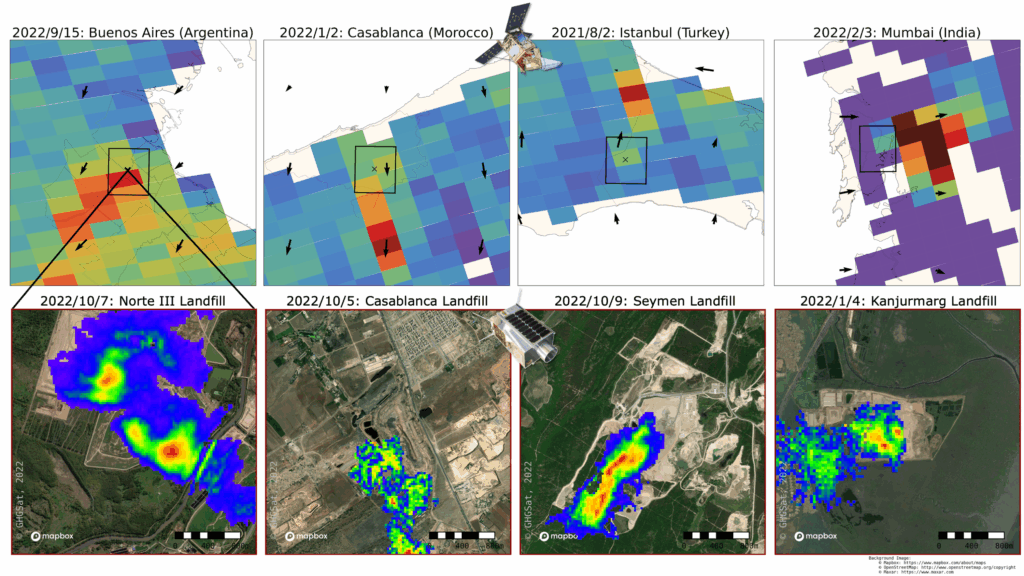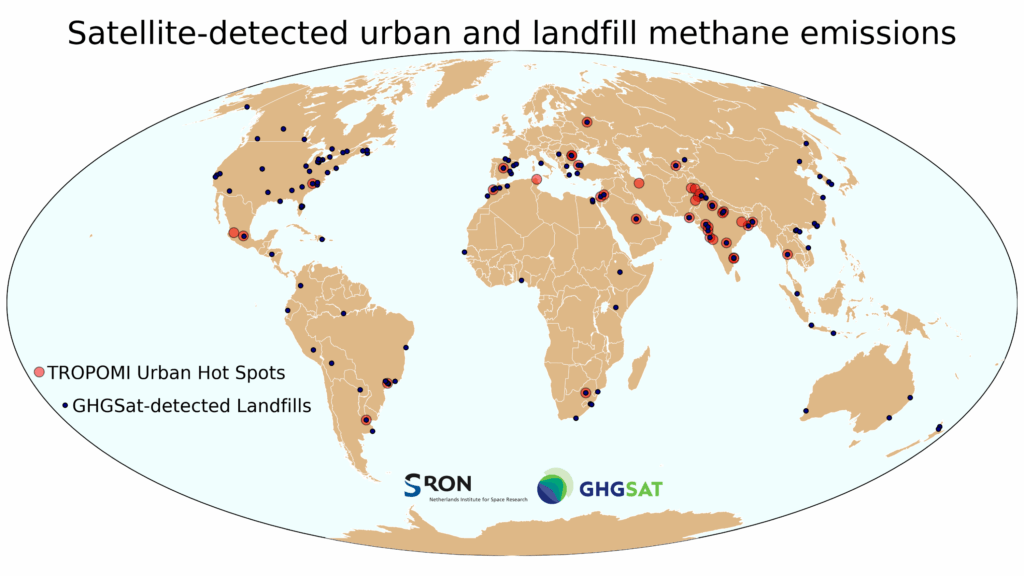Afvalverwerking is verantwoordelijk voor ongeveer 18% van de wereldwijde menselijke methaanuitstoot. Een groot deel daarvan komt van een klein aantal vuilnisbelten, wat ze tot belangrijke mitigatiedoelen maakt. Global Methane Hub, SRON en GHGSat slaan nu de handen ineen om grote emissies van vuilnisbelten over de hele wereld te identificeren, bestuderen en te monitoren. Het doel is om deze stortlocaties beter te begrijpen, een dialoog te starten en actie te bewerkstelligen op lokaal niveau. Op de COP27 presenteren ze het eerste resultaat van dit project; een wereldkaart met ruim honderd vuilnisbelten die methaan uitstoten.
Vuilnisbelten
Methaan is verantwoordelijk voor ongeveer een kwart van de menselijke opwarming van de aarde. Vuilnisbelten zijn grote geconcentreerde methaanbronnen, die ook vaak samengaan met problemen zoals grondwater- en luchtvervuiling. Reena Gupta, milieu-adviseur bij de gemeente Delhi (India), een van de lokale projectparners, zegt: ‘We zien dat slecht beheerde vuilnisbelten een enorm risico kunnen vormen voor het milieu, waarbij armere gemeenschappen worden blootgesteld aan vervuiling en stank. Deze satellietinformatie helpt ons om de vuilnisverwerking te verbeteren en om methaanemissies te verminderen. Daarmee helpen we het klimaat maar ook de leefomstandigheden in onze stad.’
grote uitstoters over de hele wereld
Een onderzoek uit 2022 onder leiding van SRON laat zien dat grote uitstoters over de hele wereld geïdentificeerd en gekarakteriseerd kunnen worden, door data te combineren van het Nederlandse ruimte-instrument Tropomi en de Canadese satelliet GHGSat. De onderzoekers gebruiken Tropomi’s wereldwijde dekking om emissie-hotspots te vinden, waarna ze de hoge resolutie van GHGSat gebruiken om de uitstoot van de individuele vuilnisbelten te meten binnen zo’n hotspot. Het onderzoek richtte zich op vier vuilnisbelten, waaronder één in Buenos Aires wiens uitstoot een klimaatimpact heeft van anderhalf miljoen auto’s. Tijdens de C40-bijeenkomst in oktober committeerde Buenos Aires zich samen met twaalf andere steden aan het reduceren van haar afvaluitstoot met dertig procent in 2030.

Global Methane Hub
Nu breiden SRON en GHGSat hun samenwerking uit binnen een nieuw project, gefinancierd door Global Methane Hub—een filantropisch fonds dat vanuit Chili is opgericht om investeringen te ondersteunen die leiden tot methaanreducties, met afval als een van haar speerpunten. Marcelo Mena, de CEO van Global Methane Hub: ‘We dragen graag bij aan dit initiatief, zodat we observaties kunnen omzetten in tastbare emissiereducties en het verbeteren van de levenskwaliteit voor minder bevoorrechte gemeenschappen die worden blootgesteld aan slecht beheerd afval.’
methaanuitstoot transparant
‘Dit nieuwe project gaat het aantal vuilnisbelten dat we kunnen onderzoeken flink verhogen,’ zegt Ilse Aben, senior scientist bij SRON Netherlands Institute for Space Research. ‘Samen met partners van over de hele wereld zorgen we dat methaanuitstoot van deze locaties transparant en nauwkeurig wordt bepaald. Het is een cruciale stap bij het ontwikkelen van de juiste strategieën om hun uitstoot terug te brengen.’



